|
I have summited Longs 43 times, most recently in July 2016. I use it for training for climbs such as Everest
and K2. I’m not an overly technical climber and use Longs as training for my
more extreme climbs in Nepal and elsewhere so it was a treat to explore a new
route (for me) with some good friends on July 23, 2013.
The Northwest Couloir was first documented by Enos Mills (aka Mills
Lake) in 1896. He noted previous evidence of earlier human activity in
the couloir. Today it is rarely climbed and often goes unnoticed by the
thousands who pass underneath on the Ledges as part of the normal Keyhole
route. I have been guilty of this for over a decade.
A bit more on Mr. Mills. He went on to summit more than 40 times
solo and served as a guide 300 more times. He was instrumental in obtaining
National Park status in 1915 for what we now call Rocky Mountain National
Park. The first documented summit of Longs was by John Wesley Powell
and a party of seven in 1868 but it is almost certain the local Native
Americans summited well before him.
The Northwest Couloir is a Class 4 climb but we used ropes to protect
the team as we found verglas near the crux move midway through the gully.
It could be climbed without protection but the margin of error is very
small and would need to be dry or climbers having solid experience in
my opinion. 
This is a different level than the Keyhole or Loft routes. I had scouted
it a few weeks before in early July and found
significant ice on the
route.
The route follows the normal Keyhole approach through the Boulderfield,
Keyhole and onto the Ledges. The NW Couloir is the last gully on the
left (East) just before the Trough. There is an earlier gully that can
be mistaken for the NW but a large rock formation at the top of the gully
resembling the Knight chess piece is the landmark to use.
The lower climb is straightforward but with the loose rock, it requires
attention especially for those below you on the Ledges. The handholds
are tenuous, more like something you would find in the Elk Range, not
on Longs. Water is often running down the Couloir making the up climb
sloppy at times.
A series of narrow rock benches create a somewhat easy route but in
general staying to the climber’s right worked well for us.
The crux, and most fun move is navigating the cave. Technically it is
not a cave but rather a gap between two huge slabs that have become lodged
in a narrow chimney, aka pancake rocks. While an alternate route is to
the right of the cave, it is a 5.2 − 5.4 slab rock climb. If covered
in verglas, as parts were on our day, it would be challenging. The exposure
to the lower Couloir is extreme. It doubtful that a cell phone would
receive a signal in the Couloir but I didn’t try. 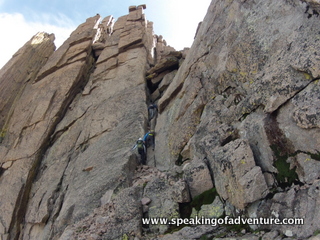
The approach to the cave is via the lower chimney leading to a false
gap. From there, a move to the right is required to see a decades old
ring piton half way hammered into the rock. I would love to know the
history of this piece.
A decent rock ledge allows for a good foothold to reach the piton and
from there a couple of aggressive moves takes you to the entrance of
the cave. It was on this move where we put in a couple of nuts for protection.
Once at the entrance, we crawled in to see a 16 inch high gap with sunlight
on the other end. Our team use a variety of gymnastic moves to wiggle
through the gap ranging from bellyflop, to backstroke to sideways crawl
but all required removing our packs.
Once through the gap, a solid rock platform allows for a safe foot plant.
The Couloir opens up above the cave returning to a Class 3 rock scramble.
At the top it joins the Keyhole Ridge route but well above the rated
5+ sections. A long series of connected slabs take you to the summit
plateau. 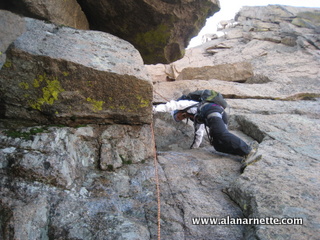
The views of the Trough and climbers looking like ants, dominate the
view 600’ below. The views of the irregular rock blocks stacked like
dominos was astounding.
Given we had a 60m rope and harnesses, we rappelled down the North Face
competing a unique and satisfying day on Longs Peak.
Climb On!
Alan
Memories are Everything
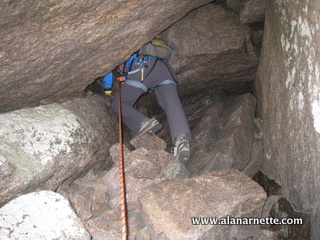
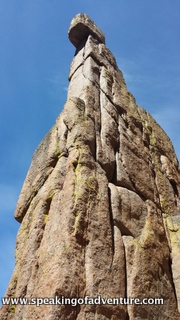

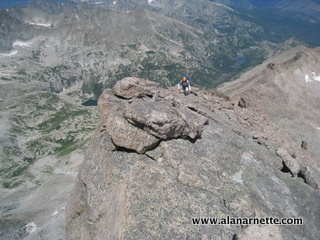

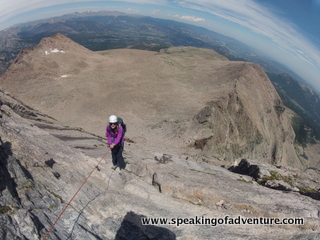
The following video was taken by myself and Jim Davidson. I hope you
enjoy.
|

